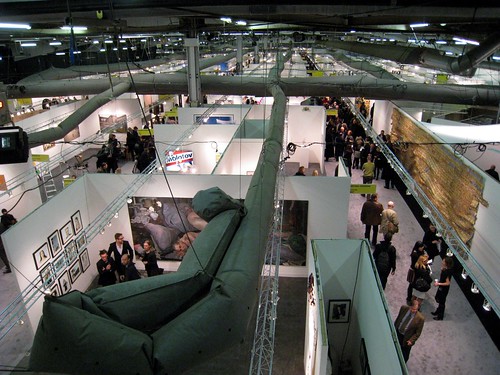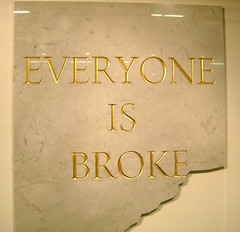there are 10 posts from March 2009
i want to know why you still read slate
Slate is too bored with ER to cover the final episode…
We have approached both staff writers and a series of reliable correspondents, inviting them to weigh in on the final episode and the legacy of the drama’s 15-year run. No one wanted the assignment.
…so they’re turning the job over to their readers and asking them to file reports on the series finale.
There’s a whole mess of interestingness packed into this little nugget (Slate’s wink wink nudge nudge that ER’s just not good enough for them to cover (but it’s fine if their readers do), the attempt at editorial direction for contributors, the obvious and lame poke at Clooney, the fact that I’m sure their readers will do a better job of it than they would have), but I’m just too busy to unpack it all.
Instead, I’m leaving it to you, my readers, to do the hard editorial work for me. Why do you still read Slate? Is Slate right for not covering the ER finale? Should they be paying more attention to culture that’s actually popular? Is their editorial voice as grating to you as it is to me? Leave all your thoughts on Slate not covering ER in the comments, and I’ll pick the best ones and repackage them as my own content in a future blog post!
from the flickr clock
I like the Flickr Clock, because it randomly helped me find this gem. Wait for the end, it feels like magic.
christopher knight on sol lewitt's last wall drawing
The LA Times’ Christopher Knight has a fantastic post up on Culture Monster about Sol LeWitt’s last public wall drawing, “Wall Drawing No. 1259: Loopy Doopy (Springfield),” installed in the new United States District Court building in Springfield, Massachusetts.
The energy of the piece derives from the way it negotiates the crazy play of its linear twists and turns with the strict rationality of the architectural setting. (The building was designed by Boston architect Moshe Safdie.) On a black acrylic ground, the wide white lines seem to emerge from the surrounding white-walled interior, which merges a rectilinear grid with a compound curve. Buildings can be eccentric, but they must also subscribe to the logic of structural codes – which an artist can happily ignore. The loopy-doopy drawing, flooded with natural light from the building’s glass facade and skylights directly above, takes that fundamental difference and runs with it.
Here’s a video that Knight took of the piece…
Knight says it “may be the most perfect union of contemporary art and architecture in the United States. It’s our Sistine.” I’d love to find an excuse to visit Springfield…
there is no medium in f2f
Meetup founder Scott Heiferman’s note on the KCET piece Is Anybody Listening:
Why does it take a camera to get people to tell their story? People looking at camera, people looking at screen. There’s an odd, passive aversion to actual, vulnerable human f2f confrontation. People telling their story to other people is infinitely scalable. F2F conversation & story-sharing is the most powerful medium. (Not really a medium – nothing in “the middle”.)
Just nabbing this excerpt of Scott’s note is a bit unfair; his first point on Is Anybody Listening is “Great piece”.
the road ahead looks rocky
Nathan Heller has a great appreciation of John Updike in n+1. This graf on Rabbit, Run is right on the money…
It’s a novel with a strong reactionary strain (a fairly misogynist one, too), but the book is also neurotically ambivalent about which trail to take: the broken Eisenhower-era family or the wayward, libertine, on-the-road life. We empathize with Rabbit, or are meant to, as much as we empathize with his pinioned wife. The book is of a piece with Updike’s native beliefs, the idea, as he put it in an interview, “that we are all a party, in one way or another, to a social contract, and when one unit in the social web takes off, there are tugs and breaks he leaves behind him.” But Rabbit’s quandary—and it’s part of the character’s tragic nature that he sees the larger meaning of his predicament—is symptomatic of a larger fracture in the culture. The road ahead looks rocky no matter where he runs. These frightening cultural fault lines gave Rabbit, Run resonance and edge—in short, its “news.”
anything for his art
I have a post brewing about RSS readers, consuming the interweb and living amongst the links. Not to give the whole thing away, but there are a few sites that I rely on as filters to the web, and kottke.org is one of them. Part of it’s the “liberal arts 2.0” editorial vision, which is right up my alley, but the other part of it is that Jason’s just a really good blogger.
Case in point: in today’s post about Michael Kontopolous’ “Machines that fall over,” Jason reports that…
I do this too, only I use chairs and my own body and frequently tip over and hurt myself. Anything for my art.
So good.
misc notes on iphone 3.0
Long time readers won’t be surprised to learn that I’m seriously considering installing the beta of iPhone v3 for one single feature alone – landscape mode in Mail, Notes and SMS. Like many others, I can probably count on three fingers the number of times I’ve missed not having copy & paste, but every single day there are two fat thumbs that long to romp through the landscape.
Other misc notes on v3:
-
Matt Jones is right on the money -- the hardware integration stuff is big news, and an area that’s wide open for crazy innovation in all sorts of verticals.
-
Mmmm, push notification services. I didn’t see any news mentions of developer pricing for that, so I assume they didn’t discuss it. This is something to watch: ESPN delivering sports scores is one thing (there are a limited number of sporting events in a year)…messaging apps are another. The use case of real-time messaging notifications (Twitter DMs, IM alerts, etc.) is going to be an interesting one from a pricing perspective, since the volume and timing of those are, by definition, out of the application developer’s control.
-
In-app purchases are also going to be very interesting from a pricing and user behavior perspective. In their conversation at SxSW, Chris Anderson and Guy Kawaski touched on the psychology of charging even $0.01 v. giving things away for free, and the mental transaction cost involved in making the decision to pay more than zero for an item. The context for that conversation was “the web,” so we’ll see if the context of “the bright shiny phone” changes that at all.
-
I’m assuming that a developer could use the in app purchase mechanism to sell a subscription or bundle of push notification messages. App developers are going to have to get savvy about pricing and business models – the guys at Pinch Media have to be loving all the things they heard yesterday.
-
I’m frankly surprised by the iPod library access APIs – I’m imagining a whole new slew of UIs for browsing and playing and interacting with your own media. Paul Lamere showed some cool music library visualization stuff from Sun’s Search Inside the Music project at SxSW – I’d love to see some of that work / thinking end up on a pocket-sized multitouch display.
Until all that stuff surfaces, though, I’m gonna be happy with my landscaped keyboard. Because on my phone, I’m all thumbs.
closing the book
My esteemed colleague David Jacobs on reading with the iPhone Kindle app.
I have one major complaint: I found the act of finishing the book unsatisfying; after paging through 4393 “locations” (the Kindle doesn’t entertain the conceit of page numbers) I missed the satisfaction of closing the volume one final time. The application resisted my impotent flicks, always returning to the final page.
toby barlow on detroit
Toby Barlow, whose book Sharp Teeth I blogged about in early 2008, has a great piece in the Times about what’s happening in Detroit – the land of $1000 houses.
Detroit right now is just this vast, enormous canvas where anything imaginable can be accomplished. From Tyree Guyton’s Heidelberg Project (think of a neighborhood covered in shoes and stuffed animals and you’re close) to Matthew Barney’s “Ancient Evenings” project (think Egyptian gods reincarnated as Ford Mustangs and you’re kind of close), local and international artists are already leveraging Detroit’s complex textures and landscapes to their own surreal ends.
In a way, a strange, new American dream can be found here, amid the crumbling, semi-majestic ruins of a half-century’s industrial decline. The good news is that, almost magically, dreamers are already showing up.
sensory overload
While in New York last week, I spent a couple hours working my way through The Armory Show, an annual massive gathering of contemporary and modern art dealers from around the world. Here’s a shot from the catwalk above the contemporary section of the fair – it’s worth viewing the 1280px wide version if only to get a better sense of scale – in this shot alone you can barely make out the four aisles of booths that were in one wing of Pier 94…
I have tremendous respect for anyone who can spend any serious amount of time with that much art and walk away with any reasonably informed opinion of what was “good” or at least “interesting.” I love this stuff, and love someone who really loves this stuff (so I’m motivated to love this stuff even more), and I only walked away with a headache.
There were two pieces from the fair that have stuck with me, though. First, this perfectly timed piece from Michael Elmgreen & Ingar Dragse…
…and this one from I don’t remember who because all I could think was “This must be how we get back to the island…”


